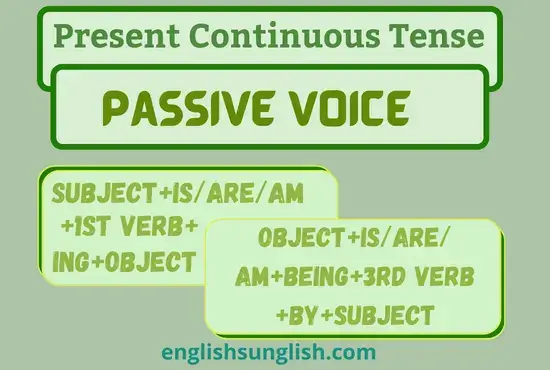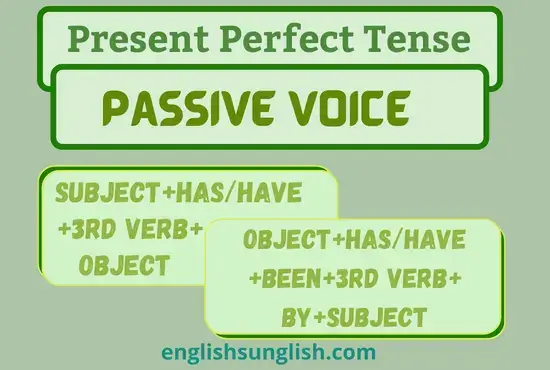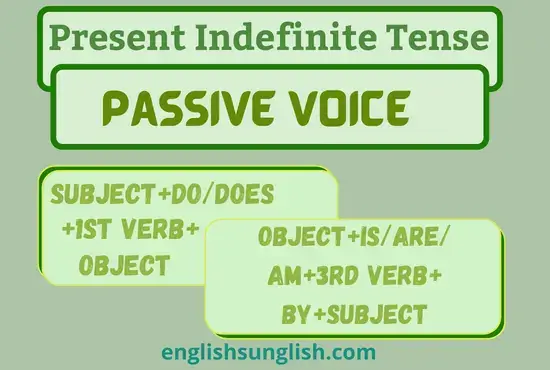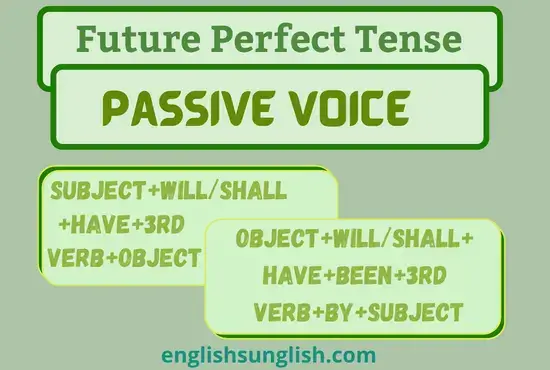Present Continuous Tense-Passive Voice

The Passive Voice of the Present Continuous Tense can be made by applying the following procedures according to the specific type of Sentences.
Helping Verbs of Passive Voice of Present Continuous Tense
Passive Voice sentences of Present Continuous Tense use “is/are/am” as helping verbs with the addition of “being”, to show the passive progressing actions of the present time. Following are helping verbs of the Present Continuous Tense that are used with respective number nouns and pronouns.
“Is Being” As a helping verb in the Present Continuous Tense
“Is being” is used as a helping verb in Passive Voice sentences of Present Continuous Tense with singular number nouns, and singular pronouns “he/she/it”.

“are being” as a helping verb in the Present Continuous Tense
“Are being” is used as a helping verb in Passive Voice Sentences of Present Continuous tense with plural number nouns and plural pronouns “We/they”, and with 1 singular pronoun “you”.

“am being” as a helping verb in the Present Continuous Tense
“Am being” is used as a helping verb in the Passive Voice of the Present Continuous Tense with only one singular pronoun “I”.

Passive Voice of Assertive Sentences Of Present Continuous Tense
The Passive Voice of the Assertive Sentence of the Present Continuous Tense can be made by applying the following rules:
- Convert the object of the Active Voice Sentence into the subject of the Passive Voice Sentence.
- Use helping verbs “is/are/am” according to the subject of the Passive Voice Sentence, which would be the object of the Active Voice Sentence.
- Use the additional helping verb “being” with “is/are/am”, to show the continuous tense.
- Use 3rd form of the verb.
- Use the word “by”, to show the doer.
- After that convert the subject of the Active Voice Sentence into the object of the Passive Voice Sentence.
- In the end, add the remaining words if there are any in the Active Voice Sentence.

Examples of Passive Voice of Assertive Sentences of Present Continuous Tense
Following are some examples of Assertive Sentences of Present Continuous Tense.
- I am writing a letter.
- A letter is being written by me.
- She is singing songs.
- Songs are being sung by her.
- She is burning those letters.
- Those letters are being burnt by her.
- We are buying tickets.
- Tickets are being bought by us.
- They are selling this bicycle.
- This bicycle is being sold by them.
- I am learning this poem by heart.
- This poem is being learned by me by heart.
- Mosquitoes are biting me.
- I am being bitten by mosquitoes.
- The children are pulling his shirt.
- His shirt is being pulled by the children.
- He is reading the book.
- The book is being read by him.
- I am eating an apple.
- An apple is being eaten by me.
- He is printing books.
- Books are being printed by him.
- They are liking cricket.
- Cricket is liked by them.
- He is posting the letter.
- The letter is being posted by him.
- I am calling the roll.
- The roll is being called by me.
- They are chasing the dogs.
- The dogs are being chased by them.
- They are flying kites.
- Kites are being flown by them.
- He is drawing water from the well.
- Water is being drawn by him from the well.
- She is learning this poem by heart.
- This poem is being learned by her by heart.
- He is writing a letter.
- A letter is being written by him.
- They are singing a song.
- A song is being sung by them.
- I am reading the book.
- The book is being read by me.
- He is selling milk.
- Milk is being sold by him.
- We are eating mangoes.
- Mangoes are being eaten by us.
- I am helping her.
- She is being helped by me.
- They are learning this poem.
- This poem is being learned by them.
- We are closing doors.
- Doors are being closed by us.
- They are buying books.
- Books are being bought by them.
- My teacher is marking my answer book.
- My answer book is being marked by my teacher.
- He is looking at us.
- We are being looked at by him.
- She is spelling many words wrongly.
- Many words are being spelled by her wrongly.
- They are offering prayers.
- Prayers are being offered by them.
- We are serving her these days.
- She is being served by us these days.
Passive Voice of Negative Sentences of Present Continuous Tense
The Passive Voice of the Negative Sentence of the Present Continuous Tense can be made by applying the following rules:
- Convert the object of the Active Voice Sentence into the subject of the Passive Voice Sentence.
- Use helping verbs “is/are/am” according to the subject of the Passive Voice Sentence, which would be the object of the Active Voice Sentence.
- Then add the word “not”, to show the negativity of the sentence.
- Then use the additional helping verb “being”, to show the continuous tense.
- Use 3rd form of the verb.
- Use the word “by”, to show the doer.
- After that convert the subject of the Active Voice Sentence into the object of the Passive Voice Sentence.
- In the end, add the remaining words if there are any in the Active Voice Sentence.

Examples of Negative Sentences of Present Continuous Tense
Following are some examples of Negative Sentences of Present Continuous Tense.
- They are not helping me.
- I am not being helped by them.
- He is not blaming me.
- I am not being blamed by him.
- He is not telling a lie.
- A lie is not being told by him.
- She is not reading the newspaper.
- The newspaper is not being read by her.
- They are not sowing those seeds today.
- Those seeds are not being sown by them today.
- They are not eating sweets.
- Sweets are not being eaten by them.
- You are not praising them.
- They are not being praised by you.
- She is not boiling eggs.
- Eggs are not being boiled by her.
- You are not speaking the truth.
- The truth is not being spoken by you.
- The teacher is not marking us absent.
- We are not being marked absent by the teacher.
- They are not feeding this lion today.
- This lion is not being fed by them today.
- You are not ringing the bell.
- The bell is not being rung by you.
- You are not boiling eggs.
- Eggs are not being boiled by you.
- They are not calling in the doctor.
- The doctor is not being called in by them.
- We are not importing wheat.
- Wheat is not being imported by us.
Passive Voice of Interrogative Sentences of Present Continuous Tense
The Passive Voice of the Interrogative Sentence of the Present Continuous Tense can be made by applying the following rules:
- Use helping verbs “is/are/am” according to the subject of the Passive Voice Sentence.
- Convert the object of the Active voice Sentence into the subject of the Passive Voice Sentence.
- Use the additional helping verb “being” with “is/are/am”, to show the continuous tense.
- Use 3rd form of the verb.
- Use the word “by”, to show the doer.
- After that convert the subject of the Active Voice Sentence into the object of the Passive Voice Sentence.
- Then, put the remaining words if there are any in the Active Voice Sentence.
- In the end, use the sign of interrogation “?”, to show the interrogative nature of the sentence.

Examples of Passive Voice of Interrogative Sentences of Present Continuous Tense
Following are some examples of Interrogative Sentences of Present Continuous Tense.
- Are you teaching him?
- Is he being taught by you?
- Are you charging me a fine?
- Am I being charged a fine by you?
- Is a fine being charged me by you?
- Is he beating my brother?
- Is my brother being beaten by him?
- Are you proving the case?
- Is the case being proved by you?
- Am I telling a lie?
- Is it a lie being told by me?
- Is he abusing me?
- Am I being abused by him?
- Are you milking the cow?
- Is the cow being milked by you?
- Are we lighting these lamps?
- Are these lamps being lit by us?
- Are you publishing this book?
- Is this book being published by you?
- Is he polishing your shoes?
- Are your shoes being polished by him?
- Is she sewing that shirt?
- Is that shirt being sewn by her?
- Are you buying tickets?
- Are tickets being bought by you?
- Are the police catching the thief?
- Is the thief being caught by the police?
- Is he dismissing the peon?
- Is the peon being dismissed by him?
- Why are you sending us to London?
- Why are we being sent to London by you?
- Are they taking the examination?
- Is the examination being taken by them?
- Are they praising her?
- Is she being praised by them?
- Is he wearing new clothes?
- Are new clothes being worn by him?
Passive Voice of Negative-Interrogative Sentences of Present Continuous Tense
The Passive Voice of the Negative-Interrogative Sentence of the Present Continuous Tense can be made by applying the following rules:
- Use helping verbs “is/are/am” according to the subject of the Passive Voice Sentence.
- Convert the object of the Negative-Interrogative Sentence into the subject of the Passive Voice Sentence.
- Then add the word “not”, to show the negativity of the sentence.
- Use the additional helping verb “being” with “is/are/am”, to show the continuous tense.
- Use 3rd form of the verb.
- Use the word “by”, to show the doer.
- After that convert the subject of the Active Voice Sentence into the object of the Passive Voice Sentence.
- In the end, add the remaining words if there are any in the Active Voice Sentence

Examples of Negative-Interrogative Sentences of Present Continuous Tense
Following are some examples of Interrogative Sentences of Present Continuous Tense.
- Are you not teaching him?
- Is he not being taught by you?
- Are you not charging me a fine?
- Am I not being charged a fine by you?
- Is a fine being charged me by you?
- Is he not beating my brother?
- Is my brother not being beaten by him?
- Are you not proving the case?
- Is the case not being proved by you?
- Am I not telling a lie?
- Is it a lie not being told by me?
- Is he not abusing me?
- Am I not being abused by him?
- Are you not milking the cow?
- Is the cow not being milked by you?
- Are we not lighting these lamps?
- Are these lamps not being lit by us?
- Are you not publishing this book?
- Is this book not being published by you?
- Is he not polishing your shoes?
- Are your shoes not being polished by him?
- Is she not sewing that shirt?
- Is that shirt not being sewn by her?
- Are you not buying tickets?
- Are tickets not being bought by you?
- Are the police not catching the thief?
- Is the thief not being caught by the police?
- Is he not dismissing the peon?
- Is the peon not being dismissed by him?
- Why are you not sending us to London?
- Why are we not being sent to London by you?
- Are they not taking the examination?
- Is the examination not being taken by them?
- Are they not praising her?
- Is she not being praised by them?
- Is he not wearing new clothes?
- Are new clothes not being worn by him?
Present Continuous Tense-Active Voice
Active Voice of Present Continuous Tense uses “is/ are/ am” with the addition of “ing” to 1st form of the verb. The following article has full rules for forming an Active Voice of the Present Continuous Tense:




